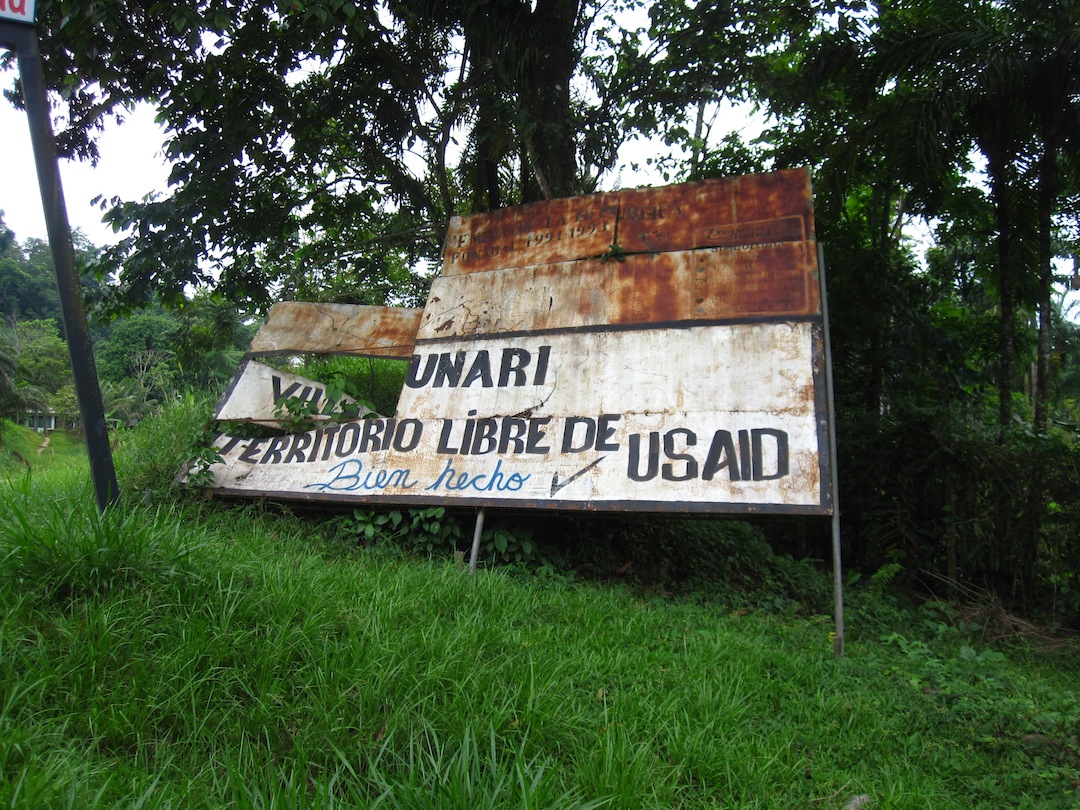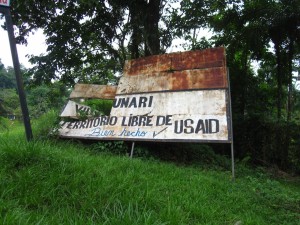
Troubling Foreign Battles in the U.S. War on Cocaine
January 24, 2012Student Blogs ArticleA little over two years ago, I spent five months as a Kiva Fellow in two of the largest coca-producing regions in the world: Ayacucho, Peru and Cochabamba, Bolivia.
Shortly after I returned to the United States, Congress passed the Fair Sentencing Act of 2010, which dramatically reduced the sentencing discrepancy between powder cocaine and crack cocaine violations. For the three decades preceding the Act’s passage, those arrested for crack cocaine offenses faced a 10-year mandatory minimum sentence for carrying only 10 grams of the drug, while a powder cocaine user would have to be caught with 1,000 grams to trigger the same penalty.
Congress was attempting to correct a policy that cut along racial lines: it was allowing white and Hispanic powder-cocaine users off the hook while locking up black crack-cocaine users. The U.S. Sentencing Commission released a statement noting that “perceived improper racial disparity fosters disrespect for and lack of confidence in the criminal justice system.” According to U.S. Senator Dick Durbin: “The sentencing disparity between crack and powder cocaine has contributed to the imprisonment of African Americans at six times the rate of whites and to the United States’ position as the world’s leader in incarcerations.”
While our domestic cocaine policy is now less overtly racist, it continues to rely on incarceration rather than rehabilitation. Rather than provide poor Americans with alternative means of income or help with addiction, it eerily mirrors what happened when America took its war on cocaine to the source: the coca farmers themselves.
When I first moved to South America, I lived in Ayacucho, Peru—the region where the vast majority of Peruvian cocaine is produced. There I learned about the ancient cultural ties between the Andean people and the coca leaf. It’s part of everyday Andean life and the leaf itself is considered sacred; it is most often chewed or used in tea. It became impossible for me to reconcile the image of an elderly Ayacuchan beggar chewing coca leaves against the image of a rich 20-something snorting lines of cocaine inside a VIP section in a Los Angeles club. Coca and cocaine seemed worlds apart, despite being of the same root.
Initially, I fully sympathized with the movement in favor of protecting the sacred coca leaf for the indigenous. It simply seemed unfair and even imperialistic to barge into a civilization that has chewed coca leaves for centuries and to burn all of the crops because U.S. citizens were getting too addicted to the powder form. In time, my opinions became tempered by some grim truths. In the region of Ayacucho, the ratio of coca for coca leaves to coca for cocaine is astonishing. I was told by a local that almost 95% percent of coca production goes directly to cocaine. At best, a meager 5% is used locally in coca leaf-based products. The demand simply isn’t as high for coca leaves as cocaine, yes—but the issue isn’t simply that. The issue is that if a farmer chooses to produce coca for cocaine instead of coca leaves, he will see his earnings multiply by the dozens. Moving from a macro to a more micro perspective, a lot of the drug production issues boil down to poverty issues—to one couple, their four children, their small home, and their ability to put food on the table.
I took the above photo upon entering the Chapare region of Cochabamba, Bolivia—home to a significant portion of the country’s coca production. The sign translates to “Villa Tunari, land free of USAID,” highlighting the region’s enduring pride at having survived the Reagan administration.
Coca production in Bolivia happens in two regions of the country: the Yungas in the north and Chapare in Cochabamba department. The Yungas coca leaves are primarily used for coca tea as the climate produces better quality leaves. That leaves hot, humid Chapare—a region hidden in cloud forest and jungle—as the prime location for producing coca for cocaine. Chapare, to Bolivians and perhaps US citizens who’ve followed the drug war, has been a major point of pressure from the DEA.
When the DEA entered Chapare in the 1980s, coca plantations were set ablaze and the farmers were given next to nothing to begin their rebuilding. Over the years, and in an effort to create a more sustainable form of “eradication,” USAID began implementing alternative-to-coca programs which offered seeds and funding for establishing alternative crops in the tropical region. However, much of this was a bureaucratic failure and proved catastrophic for local farmers. For example, coca farmers would stop their coca crop, and then were given seeds for orange trees. It takes years for orange trees to reach the size needed to begin producing oranges, and in those years, the former coca farmers were destined to have zero income. This was very problematic, not to mention disastrous for the farmers themselves.
Four years ago, USAID was kicked out of Chapare. Emboldened by Evo Morales, the country’s first fully-indigenous President in over 500 years and a coca farmer himself, the citizens of Chapare had had enough of the failed policies and strategies of USAID interfering with their lives. In a bold but unsurprising move, Evo Morales kicked the DEA out of Bolivia, believing the solutions could be much better coming from home.
Nevertheless, it is important to note that since Evo Morales became President, cocaine production has climbed to over 60% above its previous threshold in Bolivia. The USAID policy has not worked, and neither has Evo Morales’s strategy of pressuring coca farmers to create other products from coca leaves, such as traditional medicine, coca-scented products, and the like.
Where do we stand now? Domestic attempts to combat cocaine have resulted in increased incarceration and institutionalized racism. Our foreign attempts to nip cocaine in its literal bud have left behind a harrowing colonialist imprint on South Americans. Just last week, the Wall Street Journal explored the tattered state of Bolivian efforts to combat coca production at the seed.
Many critics of the drug war offer the answer that Bolivia, and the United States for that matter, should just legalize cocaine. The argument is appealing, but it is eons away from achieving any widespread traction in public opinion or legislatures. The trade will continue to cause bloody conflict because it will continue to be profitable, whether it is illicit or not. For the time being, American domestic and foreign policy must continue to rectify its legacy of making the poor poorer and minorities more marginalized.
You may also like
2 comments
- November 2024
- October 2024
- April 2024
- March 2024
- February 2024
- November 2023
- October 2023
- April 2023
- March 2023
- February 2023
- January 2023
- December 2022
- November 2022
- October 2022
- May 2022
- April 2022
- March 2022
- February 2022
- January 2022
- December 2021
- November 2021
- October 2021
- May 2021
- April 2021
- March 2021
- February 2021
- January 2021
- November 2020
- October 2020
- September 2020
- August 2020
- July 2020
- June 2020
- May 2020
- April 2020
- March 2020
- February 2020
- January 2020
- November 2019
- October 2019
- September 2019
- April 2019
- February 2019
- December 2018
- November 2018
- October 2018
- September 2018
- March 2018
- February 2018
- January 2018
- December 2017
- November 2017
- October 2017
- September 2017
- May 2017
- April 2017
- March 2017
- February 2017
- December 2016
- November 2016
- October 2016
- April 2016
- March 2016
- February 2016
- January 2016
- December 2015
- November 2015
- October 2015
- June 2015
- May 2015
- April 2015
- March 2015
- February 2015
- January 2015
- December 2014
- November 2014
- October 2014
- August 2014
- March 2014
- February 2014
- January 2014
- December 2013
- November 2013
- October 2013
- September 2013
- May 2013
- April 2013
- March 2013
- February 2013
- January 2013
- December 2012
- November 2012
- October 2012
- September 2012
- June 2012
- April 2012
- March 2012
- February 2012
- January 2012
- December 2011
- November 2011
- October 2011
- September 2011
- August 2011
- April 2011
- March 2011
- November 2010
- October 2010
- September 2010

I wonder if outright US legalization of drugs would actually fix South American farmers’ problems. Legalization might simply lower their profit margins of South American farmers and encourage American companies to take over the drug business to the point where farmers have no effective market. While there may be some benefits for South America if corporations were involved in the drug trade instead of cartels (as the former usually use less violence), and while legalization might prevent US forces from setting South Americans’ farms ablaze, I’m not entirely sure if legalization would make South American farmers’ lives much better in the long run.
Unfortunately, this seems like one of those bad situations where either option seems to tread on the lives of a bunch of largely innocent people.
“The argument is appealing, but it is eons away from achieving any widespread traction in public opinion or legislatures. ”
It’s the *only* option. Just advocate for legalization — it may be closer to being possible than people think.
Of course, more will have to be done after legalization, but none of it *can* be done before legalization. The mess created by Prohibition should be a lesson; it was much more possible to reduce drinking problems after Prohibition was repealed than when it was in force.